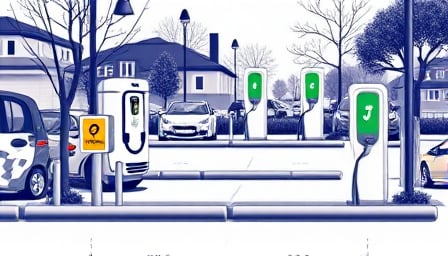Stellantis NV: Navigating Electric‑Vehicle Innovation, Capital Strategy, and Analyst Sentiment
New Battery Technology: A Strategic Pivot or a Tactical Stopgap?
In the past week, Stellantis NV announced the launch of a new electric‑vehicle (EV) battery that is described as “lighter” and “fast‑charging.” On the surface, the claim appears to reinforce the company’s commitment to electrification after it abandoned the earlier target of 100 % EV sales by 2030. A deeper examination raises several questions about the technology’s commercial viability and its strategic fit within Stellantis’s broader portfolio.
Technological fundamentals.
Industry analysts note that the battery’s reported weight reduction of 12 % and charging time of 15 % over current Nissan Leaf‑grade cells could translate into a 5 % improvement in vehicle range, assuming similar energy densities. However, the manufacturing complexity associated with the new chemistry—reported to involve a proprietary lithium‑sulfur composite—could inflate cycle life costs. Current lithium‑sulfur prototypes typically suffer from rapid capacity fade, which could necessitate earlier battery replacements and erode resale values.
Regulatory environment.
The European Union’s upcoming “Battery Directive” will require stricter life‑cycle assessments and recycling obligations by 2028. If Stellantis’ new chemistry fails to meet the directive’s recyclability thresholds, the company may face penalties or be forced to redesign the battery before it reaches the market. In contrast, the United States has a less prescriptive regulatory framework, which may provide a short‑term advantage for rollout in North America.
Competitive dynamics.
Tesla, BYD, and the new entrants from the automotive‑tech space (e.g., Rivian, Lucid) are already testing next‑generation chemistries with higher energy densities and lower costs. Stellantis’ announced battery improvement appears modest relative to Tesla’s 4680 cell upgrades. The risk, therefore, is that the new battery will only provide a marginal competitive edge unless paired with significant price reductions or superior vehicle integration.
Opportunity assessment.
If Stellantis can secure a cost advantage through economies of scale in its global supply chain—particularly via its recent partnership with the German battery manufacturer SK On—the new battery could become a differentiator in the mass‑market segment. Moreover, the reduced weight aligns with the company’s long‑term goal of improving fuel economy across its commercial vehicle line, potentially opening a cross‑segment revenue stream.
Debt Financing: Confidence or Cushioning?
Stellantis’ subsidiary’s issuance of R$ 1.7 billion in letters of credit (LOCs) signals an active strategy to leverage Brazil’s relatively low-cost capital markets. The move, while not unprecedented for a multinational automaker, raises several analytical points.
Financial fundamentals.
The LOCs provide a short‑term liquidity cushion that can be drawn upon for vehicle production ramps or for filling the supply chain gaps that have plagued the industry since the pandemic. However, the 3.5 % coupon on these LOCs—lower than the current market rate for similar instruments—may reflect a perceived low risk in Brazil’s sovereign rating, but also indicates that Stellantis is benefiting from favorable market conditions.
Risk analysis.
Brazil’s economic volatility, including inflationary pressures and currency risk, could erode the real value of these funds if the company must convert them to euros or dollars for European production. Furthermore, the LOCs are contingent on the subsidiary’s creditworthiness, which could be jeopardized if the parent company faces liquidity strain from its EV investments.
Strategic implications.
By drawing on Brazilian capital rather than U.S. or European debt markets, Stellantis diversifies its funding sources, reducing its exposure to the tightening conditions in European bond markets post‑Eurozone debt crisis. Additionally, the LOCs can be used to support local assembly plants, enhancing the company’s “buy‑local” strategy in emerging markets—a key component of its 2030 sustainability roadmap.
Analyst Upgrades: A Cautious Optimism
Several analysts have upgraded Stellantis to a “Buy” rating, citing an improved outlook. While the upgrade is a positive signal, it warrants a critical appraisal.
Valuation metrics.
The current price‑to‑earnings (P/E) ratio of 12× falls below the sector average of 15×, suggesting undervaluation. However, the EV transition is still a cost center for Stellantis, with projected EV unit costs at 25% higher than ICE vehicles until 2026. The upside potential depends on the speed at which cost reductions materialize.
Market positioning.
Stellantis’ global market share in the U.S. has plateaued at 6 %. The new battery may not be enough to accelerate penetration without significant marketing and pricing strategies. Analysts who focus on the company’s global footprint might overlook the regional disparities that could blunt overall growth.
Risk mitigation.
The upgrades often overlook the risks associated with the company’s reliance on legacy platform engineering. If Stellantis delays the shift to a dedicated EV architecture, the company could fall behind competitors who are investing heavily in modular platforms that allow rapid iteration.
Conclusion
Stellantis NV’s latest developments—the introduction of a lighter, faster‑charging EV battery and the strategic issuance of R$ 1.7 billion in letters of credit—reflect a company balancing ambition with pragmatism. The battery’s technological advantages must be weighed against manufacturing challenges and regulatory hurdles. Meanwhile, the debt financing illustrates a deliberate diversification of capital sources but carries exposure to emerging‑market risks.
Analyst upgrades point to confidence in the company’s long‑term prospects, yet a skeptical inquiry underscores the need for clear cost‑reduction pathways and a robust commercialization strategy. As Stellantis continues to navigate the transition to electrified mobility, its ability to translate technological innovation into market leadership will be the ultimate test of its corporate strategy.
